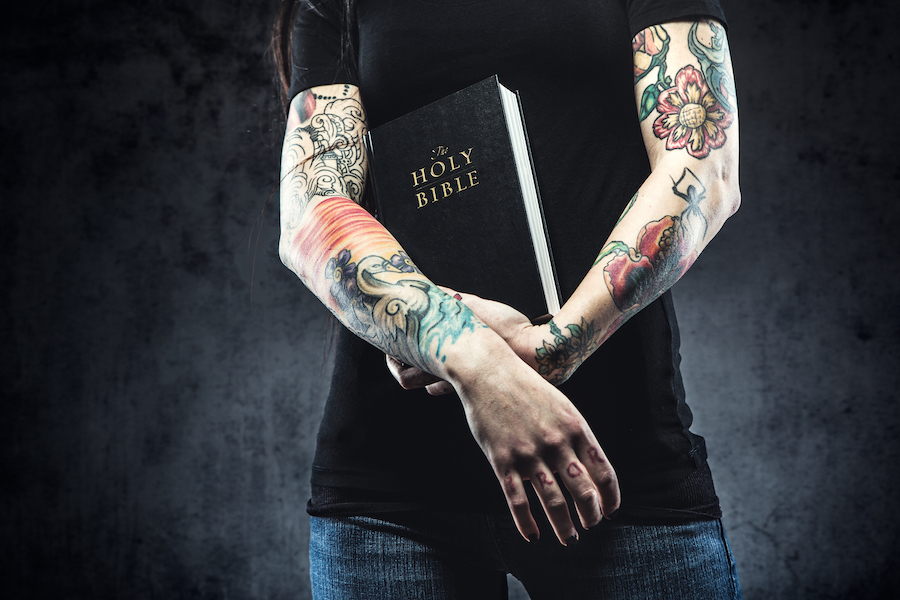Are College Students with Religious Tattoos More Religious? Yes and No
Recent study explores connection between tattoos, religiosity and deviance

A recent study examined the behaviors of college students with tattoos, including religious tattoos.
Contact: Shelby Cefaratti-Bertin, Baylor University Media & Public Relations, 254-327-8012
Follow us on Twitter: @BaylorUMedia
WACO, Texas (May 15, 2023) – For most of U.S. history, tattoos have been associated with sailors and bikers but not church-going people. As tattoos have become more popular, with nearly one-third of U.S. adults sporting at least one tattoo, religious-themed tattoos have also increased. A recent study examined the behaviors of college students with tattoos, including religious tattoos.
Jerome R. Koch, Ph.D., professor of sociology at Texas Tech University, and Kevin D. Dougherty, Ph.D., professor of sociology at Baylor, investigated the relationship between tattoos, religiosity and assumed behaviors. Koch and Dougherty published their research, Tattoos, Religiosity, and Deviance Among College Students, in the journal Sociological Focus.
The researchers used survey data from 3,525 students at 12 American colleges and universities to determine if there is a negative association between tattoo adornment and religiosity and whether the type of tattoo (religious or secular) is related to deviant behaviors such as drinking, drug use and sexual activity.
Results demonstrate college students with tattoos are similar to their untattooed classmates in regard to their religious faith and frequency of prayer. However, students with religious tattoos have a stronger faith, pray more and attend religious services more often than students with no tattoos or secular tattoos.
“Religious tattoos tend to be a vivid expression of strong faith and regular religious practice,” Koch said.
In contrast, findings also show students with religious or secular tattoos are similar in other surprising ways, such as marijuana use and sexual activity.
“Students with religious tattoos are highly religious in some ways but strikingly secular in others,” Dougherty said.
A potential explanation for this irony may be that tattooed individuals are sensation-seekers. The emotional content and practices associated with tattoos and religion may parallel each other in specific ways. Both tattoos and religion can signify belonging, identity, restoration, celebration and a commemoration of birth and death. These kinds of incidents and emotions are especially evident in the lives of those who hold strong religious beliefs and engage in religious experiences. In short, tattoos and religion are sensational.
“The religiously tattooed are more likely to use marijuana and be sexually active than those with no tattoos. Thus, the behavior of those with religious tattoos is more similar to those with secular tattoos and distinct from those with no tattoos. Tattoos, religious or otherwise, seem to be associated with a more sensory way of life,” Koch said.
This research adds to the scholarly understanding of how aspects of identity are connected to tattoos and religion. Koch and Dougherty began collaborating on religious tattoos in 2018. Their collaborations have produced two journal articles and a book chapter. They have plans for more research together.
“Religious tattoos are a fascinating example of how people connect with and communicate their faith,” Dougherty said. “Social scientists have largely ignored religious tattoos. Our research brings attention to these marks of faith.”
Tattoos are popular, especially among Millennials and Gen Z. Religious tattoos reveal that religion still matters to younger generations of Americans, but the influence of religion may be different than it was for previous generations.
This work was supported by a grant from the E.A. Franklin Charitable Trust.
ABOUT KEVIN DOUGHERTY, PH.D.
Kevin Dougherty, Ph.D., is an award-winning teacher and active researcher. He teaches large sections of Introduction to Sociology almost every semester. At the graduate level, he teaches the Seminar in Teaching and The Sociology of Religious Organizations. His research explores religious affiliation, religious participation, racial diversity in congregations, congregational growth and decline, and the impact of religion on other realms of social life, such as community involvement, politics and work. He also regularly writes and speaks about innovative teaching. His published research appears in leading academic journals and has been featured in news media such as the Chronicle of Higher Education, CNN, National Public Radio and USA Today.
ABOUT BAYLOR UNIVERSITY
Baylor University is a private Christian University and a nationally ranked Research 1 institution. The University provides a vibrant campus community for more than 20,000 students by blending interdisciplinary research with an international reputation for educational excellence and a faculty commitment to teaching and scholarship. Chartered in 1845 by the Republic of Texas through the efforts of Baptist pioneers, Baylor is the oldest continually operating University in Texas. Located in Waco, Baylor welcomes students from all 50 states and more than 100 countries to study a broad range of degrees among its 12 nationally recognized academic divisions.
ABOUT THE COLLEGE OF ARTS & SCIENCES AT BAYLOR UNIVERSITY
The College of Arts & Sciences is Baylor University’s largest academic division, consisting of 25 academic departments in the sciences, humanities, fine arts and social sciences, as well as 11 academic centers and institutes. The more than 5,000 courses taught in the College span topics from art and theatre to religion, philosophy, sociology and the natural sciences. The College’s undergraduate Unified Core Curriculum, which routinely receives top grades in national assessments, emphasizes a liberal education characterized by critical thinking, communication, civic engagement and Christian commitment. Arts & Sciences faculty conduct research around the world, and research on the undergraduate and graduate level is prevalent throughout all disciplines. Visit the College of Arts & Sciences website.